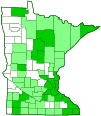eastern poison ivy
(Toxicodendron radicans ssp. negundo)
Conservation • Weed • Wetland • Description • Habitat • Ecology • Use • Distribution • Taxonomy
Description |
||
Eastern poison ivy is a climbing or trailing, perennial, woody vine that rises from a usually underground rhizome. It often forms colonies. Stems are woody and produce abundant, centipede-like aerial roots that grasp the host tree. Leaves are alternate on long, slender, densely hairy leaf stalks. The leaves are divided into 3 leaflets. The leaflets may be egg-shaped, with the broad portion at the base where it attaches to the leaf stalk, or elliptic, broadest in the middle and tapering toward both ends. They taper to a point at the tip. They are 1″ to 6″ long. The two side leaflets are usually shorter than the central leaflet. The leaflet margins may have shallow lobes, they may have rounded teeth, or they may be entire. They tend to be flat, not folded along the midrib. Young leaves are reddish-purple, becoming somewhat shiny and greed with maturity. In the fall the leaves turn yellow, orange, or bright red. Black spots may appear on any part of the plant. The spots are urushiol, the resin that causes allergic reactions. When the plant is damaged urushiol is exuded in an attempt to seal off the damaged area. The resin is creamy, turning brown-red then black with oxidation. The inflorescence is a 3″ to 4″ long cluster with usually more than 25 flowers. The flower has 5 yellowish green petals. The fruit is a smooth, dull white berry with a few gray stripes. The fruit cluster is stalked and hangs downward. |
||
Height |
||
10″ to 36″ |
||
Flower Color |
||
Yellowish green |
||
Similar Species |
||
Western poison ivy (Toxicodendron rydbergii) is a shrub, not a vine. It does not climb trees. The stems do not have aerial roots. The leaf stalks are hairless. The leaflets tend to be folded slightly along the midrib, not flat. The inflorescence is 4″ to 16″ long. The fruit cluster is compact and erect. |
||
Habitat |
||
Woods, wood edges, wooded flood plains. Light shade to full sun. |
||
Ecology |
||
Flowering |
||
June to August |
||
Pests and Diseases |
||
Poison ivy sawfly (Arge humeralis): First instar larvae skeletonize the leaves, eating the leaf tissue and leaving only the midrib and the main veins. |
||
Toxicity |
||
The sap of this plant contains the allergenic urushiol. Urushiol is not a single chemical but a complex of five chemicals called alkylcatechols. Several exposures to the substance may be necessary to impart sensitivity. Research has shown that 85% of all people will develop contact dermatitis after adequate exposure. It usually takes 12 to 48 hours for a rash to develop on a previously sensitized person. In some individuals, a single exposure will cause a reaction. In these individuals, the rash will develop in seven to ten days. The lesions last 14 to 20 days. Rashes do not spread and are not contagious. Treatment can dry the blisters, reduce swelling, and relieve itching, but will not speed healing. Contact with the outer surface on an undamaged plant should not cause an allergic reaction unless there is residual urushiol present from a previous injury to the plant or a nearby plant. Contact with a torn leaf, broken or damaged stem or rhizome, or black spot will cause a reaction in those sensitized to urushiol. |
||
Use |
||
|
||
Distribution |
||||
|
Sources 2, 3, 4, 5, 7, 8, 22, 24, 28, 29, 30. All sources but one show this species uncommon in Minnesota, with records in a dozen or fewer counties, and those mostly in the southeast quarter of the state. BONAP shows this species distributed throughout the state and occurring in most counties (light green on the map). |
|||
| 2/20/2023 | ||||
Nativity |
||||
Native |
||||
Occurrence |
||||
Uncommon in Minnesota |
||||
Taxonomy |
|||
| Kingdom | Plantae (Plants) | ||
| Division | Tracheophyta (Vascular Plants) | ||
| Subdivision | Spermatophytina (Seed Plants) | ||
| Class | Magnoliopsida (Dicots) | ||
Order |
Sapindales (soapberries, cashews, mahoganies, and allies) | ||
Family |
Anacardiaceae (cashew) | ||
| Subfamily | Anacardioideae (cashews, sumacs, and allies) | ||
Genus |
Toxicodendron (poison ivies and oaks) | ||
Subordinate Taxa |
|||
|
|||
Synonyms |
|||
Toxicodendron radicans var. negundo |
|||
Common Names |
|||
common eastern poison-ivy common poison-ivy eastern poison ivy eastern poison-ivy poison ivy |
|||
Glossary
Entire
Continuous; not toothed, notched, or lobed.
Rhizome
A horizontal, usually underground stem. It serves as a reproductive structure, producing roots below and shoots above at the nodes.
Urushiol
Collectively, the five chemicals (alkylcatechols) in the sap of Toxicodendrons that cause allergic reactions in humans.
Visitor Photos |
|||||
Share your photo of this plant. |
|||||
| This button not working for you? Simply email us at info@MinnesotaSeasons.com. Attach one or more photos and, if you like, a caption. |
|||||
Travis Miller |
|||||
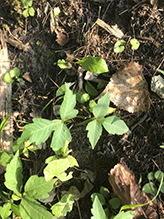 |
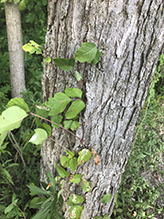 |
||||
MinnesotaSeasons.com Photos |
|||||
|
|||||

Slideshows |
||
| Poison Ivy Andree Reno Sanborn |
||
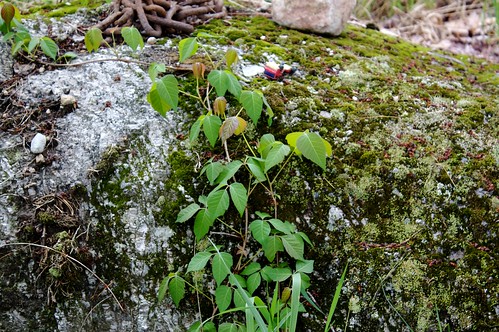
|
||
About
Toxicodendron radicans |
||
| Toxicodendron radicans (Poison-Ivy) Allen Chartier |
||
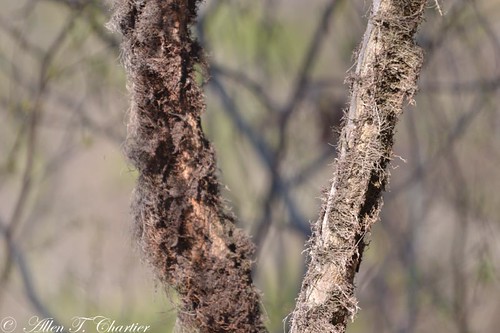
|
||

Visitor Videos |
|||
Share your video of this plant. |
|||
| This button not working for you? Simply email us at info@MinnesotaSeasons.com. Attach a video, a YouTube link, or a cloud storage link. |
|||
Other Videos |
|||
| toxicodendron radicans josh veazey |
|||
About
Published on Apr 24, 2012 documentary on toxicodendron radicans |
|||
| Toxicodendron radicans (Poison Ivy) Plantwalks |
|||
About
Published on Nov 17, 2012 He won't bring this to class.... would he? |
|||
| How to ID Poison Ivy: It's My Park Minute NYC Parks |
|||
About
Published on Aug 21, 2013 Ghanim Khalil, an Urban Park Ranger with NYC Parks in Willowbrook Park, Staten Island, explains how to identify and avoid poison ivy, aka Toxicodendron radicans. Subscribe to www.youtube.com/nycparksdepartment to learn more about NYC Parks. Produced by Adrian Sas |
|||
| Poison Ivy Will DESTROY You DNews |
|||
About
Published on Jun 16, 2013 Summer's here and with it comes more time outdoors. But be warned: some of those newly sprouted plants are out to get you! Namely, Poison Ivy! Trace shows us what makes this plant one of the wickedest out there. Read More: Beware America's Most Poisonous Plants Poison Ivy, Oak, or Sumac - Topic Overview Outsmarting Poison Ivy and Other Poisonous Plants
http://www.fda.gov/forconsumers/consumerupdates/ucm049342.htm Poison Ivy: Toxicodendron radicans Poison Ivy Irritating to Humans but Good for Wildlife Giant, Toxic Weed Poses Health Risk Watch More: |
|||
| Poison Ivy ExploringWithGeorge |
|||
About
Published on Jul 28, 2013 If you spend time in the outdoors you are going to run into poison Ivy Toxicodendron radicans, commonly known as poison ivy, is a poisonous North American plant that is well known for its production of urushiol, a clear liquid compound found within the sap of the plant ... Wikipedia |
|||

|
Created: Last Updated: © MinnesotaSeasons.com. All rights reserved. |
